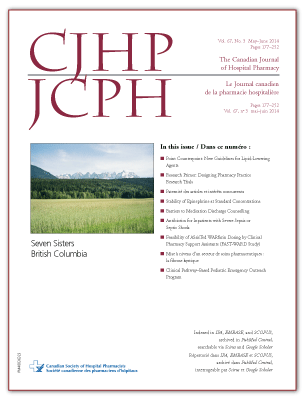Feasibility of ASsisTed WARfarin Dosing by Clinical Pharmacy Support Assistants (FAST-WARD Study)
DOI:
https://doi.org/10.4212/cjhp.v67i3.1359Keywords:
warfarin, clinical pharmacy support assistant, anticoagulation, pharmacy practice, warfarine, assistant au soutien de la pharmacie clinique, anticoagulothérapie, pratique pharmaceutiqueAbstract
ABSTRACT
Background: Pharmacy-managed warfarin dosing has been established at Burnaby Hospital, in Burnaby, British Columbia, for over 10 years. With increases in the number and acuity of patients enrolled, it has become challenging to maintain a successful anticoagulation program. The clinical pharmacy support assistant (CPSA) program was initiated to support the provision of clinical pharmacy services. At the time of the study, Burnaby Hospital had 2 CPSAs. It was anticipated that the pharmacy-managed inpatient warfarin dosing service might benefit from support through the CPSA program to maintain a consistent level of delivery.
Objective: To examine the feasibility of CPSAs supporting the pharmacy-managed inpatient warfarin dosing service at Burnaby Hospital. Feasibility was based on 4 key parameters: knowledge base, accuracy of data collection, dosage recommendations, and time spent on the process.
Methods: An observational, prospective pilot study was conducted over 3 months. The CPSAs were given appropriate education and training, and their performance was assessed to determine the feasibility of CPSAassisted warfarin dosing. The CPSAs had to achieve a priori target scores for each of the 4 parameters in order for CPSA-assisted warfarin dosing to be considered feasible.
Results: After the didactic sections, both CPSAs answered all review questions correctly. The accuracy of data collection (based on 60 patient encounters) was 98.3%. The warfarin regimens recommended by the CPSAs were similar to those recommended by the clinical pharmacists, with doses differing by a mean of 0.46 mg. For 39 (65%) of the 60 patient encounters, the dosing recommendations of CPSAs and clinical pharmacists were identical. The average time spent per patient encounter was 10.5 min.
Conclusion: With appropriate training and education, it is feasible for CPSAs to support the pharmacy-managed inpatient warfarin dosing program at Burnaby Hospital.
RÉSUMÉ
Contexte : Un programme d’ajustement posologique de la warfarine géré par le pharmacien est en place à l’hôpital Burnaby depuis plus de 10 ans. Comme le nombre de patients inscrits au programme s’accroît et que la gravité des cas augmente, il est maintenant difficile pour le programme d’anticoagulothérapie de conserver le même niveau de performance. Le programme d’assistant au soutien de la pharmacie clinique (ASPC) a été mis en place dans le but de soutenir la prestation de services de pharmacie clinique. Au moment de l’étude, l’hôpital Burnaby avait deux ASPC. Le service d’ajustement par le pharmacien de la posologie de la warfarine des patients hospitalisés pourrait bénéficier du soutien du programme d’ASPC afin de conserver un niveau de prestation uniforme.
Objectif : Étudier la possibilité pour les ASPC de soutenir le service d’ajustement par le pharmacien de la posologie de la warfarine des patients hospitalisés offert par l’hôpital Burnaby. La faisabilité était fondée sur quatre paramètres clés : la base de connaissances, l’exactitude de la collecte de données, les recommandations posologiques et le temps alloué au processus.
Méthodes : Une étude pilote prospective observationnelle a été menée sur une période de trois mois. Les ASPC ont obtenu un enseignement et une formation adéquate et, suite à cela, leur travail a été évalué dans le but de déterminer si une aide à l’ajustement posologique de la warfarine est possible. Les ASPC devaient atteindre des scores prédéfinis a priori pour chacun des quatre paramètres pour que leur aide à l’ajustement posologique de la warfarine soit considérée comme faisable.
Résultats : Après avoir participé aux volets didactiques, les deux ASPC ont répondu correctement à l’ensemble des questions d’évaluation. L’exactitude de la collecte de données (fondée sur 60 rencontres avec des patients) était de 98,3 %. Les schémas posologiques de warfarine recommandés par les assistants étaient semblables à ceux recommandés par les pharmaciens cliniciens et variaient en moyenne de 0,46 mg. Pour 39 (65 %) des 60 rencontres avec des patients, les recommandations posologiques des assistants étaient identiques à celles des pharmaciens
cliniciens. Chaque rencontre durait en moyenne 10,5 minutes.
Conclusion : À l’aide d’une formation et d’un enseignement adéquats, il est donc possible pour les ASPC de soutenir le programme d’ajustement par le pharmacien de la posologie de la warfarine des patients hospitalisés offert par l’hôpital Burnaby.
Downloads
Published
Issue
Section
License
Copyright © Canadian Society of Healthcare-Systems Pharmacy.
After publication of a manuscript in the CJHP, the authors of the manuscript must obtain written permission from the CSHP (publications@cshp.ca) before reproducing any text, figures, tables, or illustrations from the work in future works of their own. If a submitted manuscript is declined for publication in the CJHP, all said rights shall revert to the authors. Please note that any forms (e.g., preprinted orders and patient intake forms) used by a specific hospital or other health care facility and included as illustrative material with a manuscript are exempt from this copyright transfer. The CJHP will require a letter from the hospital or health care facility granting permission to publish the document(s).










